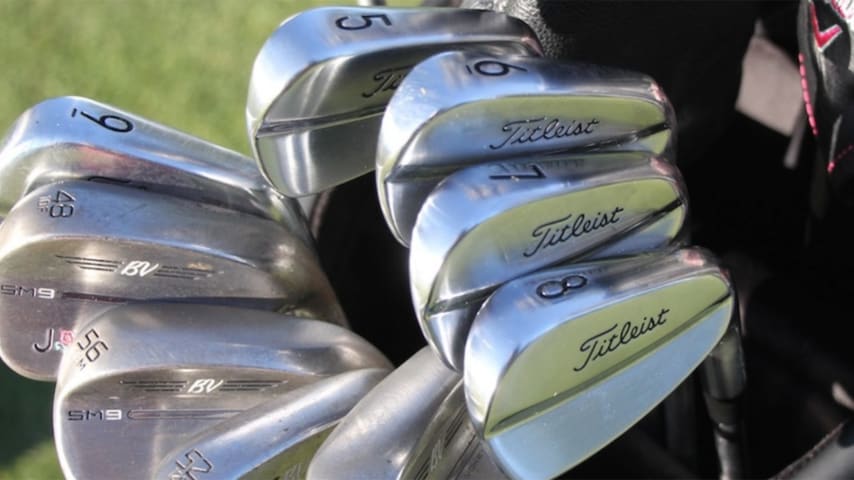Justin Rose took a unique route to new Titleist irons
4 Min Read

Written by GolfWRX
“A blade is just a blade.”
In the world of golf equipment, that phrase is often used to express the belief that all muscleback blade irons – which are typically characterized by their thin toplines and compact shapes – are similar enough in their simplicity that the differences are negligible.
Justin Rose, the former FedExCup and U.S. Open champion, doesn’t subscribe to that theory.
For the last several years, Rose – who’s currently a golf club free agent (aside from a deal with Axis1 to use its putters) – has used a variety of iron brands and models, including multiple blade designs. As of this year’s Masters, Rose was using a set of TaylorMade P7MC irons, which feature a compact, cavity-back design. By the time he next teed it up at the PGA Championship, however, he had switched into his current Titleist 620 Forged MB blade-style irons.
Rose finished 13th in the PGA and is coming off a fourth-place finish at last week’s RBC Canadian Open, where he flirted with the lowest round in TOUR history before settling for a 60. How he settled on the new clubs is an interesting story, different than how most of his peers pick their equipment. Most TOUR players test out equipment on the range at tournaments, utilizing the expertise of dedicated club fitters employed by the equipment companies to get them dialed in.
Rose, however, visited an off-site clubfitting facility in London, Custom Golf Works Sunningdale in London. The fitter boasts a decade of fitting players on the DP World Tour but also is open to the public. It isn’t affiliated with a single equipment brand. The Titleist clubs simply won out after Rose’s testing sessions. By enlisting Custom Golf Works Sunningdale to conduct his club fitting, Rose could focus less on equipment testing during tournament weeks.
“We just went through a few different heads, and I really like the look of the Titleist (620 Forged MB),” Rose told GolfWRX on Tuesday. “I tested them, and they actually performed really, really well. Launch, spin, and also I think a little bit of dispersion. You’re not going to get a ton of difference (between blade iron designs); it’s more just comfort with how they looked. But the more I (use different blades), the more there are subtle differences between certain irons. These ones I’m beginning to learn they come out a little quicker out of the rough. A few more jumpers, which might just be a groove thing. Off the fairway, they spin just as much and just as good.”
Playing out of the rough always is a big part of the U.S. Open and this week at The Country Club will be no different. The long grass creates an increased challenge for players when hitting approach shots into the course’s small and undulating greens.
Thick grass usually causes shots to fly shorter because the grass creates greater resistance against the club at impact. The opposite can happen, however, when strands of grass get caught between the ball and clubface in a way that reduces spin, but not speed or distance. Sometimes, though, strands of grass get caught between the golf ball and the club face in a way that reduces spin, but not speed or distance. When this happens, it’s called getting a “jumper,” or a “flier,” and the ball travels noticeably farther. The only problem with a jumper is that it flies like a knuckleball, making it difficult to hit and stop on the green; when harnessed effectively, though, getting a jumper can be quite useful. Rose noted that his new clubs produce more “jumpers” out of the rough than his previous set.
“A jumper can be a valuable club in the bag if you learn how to play it properly, so that’s the adjustment I’m learning to make with those (Titleist irons),” Rose told GolfWRX.com on Tuesday.
Since a “flier” or “jumper” can actually increase distance in certain circumstances, learning how to properly harness it can give a player the opportunity to take less club and use a higher-lofted iron for an approach shot, using the shot’s increased height and steeper angle of descent to help it stop on the greens.
As Rose noted above, it may be the grooves that makes his Titleist irons faster from the rough. By that he means the layout, depth, width and sharpness of the grooves on the faces of his 620 Forged MB model irons are possibly different than other blade irons. Since different groove configurations and designs produce different amounts of friction, they can achieve different performance characteristics.
He'll look to harness the “jumpers” this week as he seeks a second U.S. Open title.






